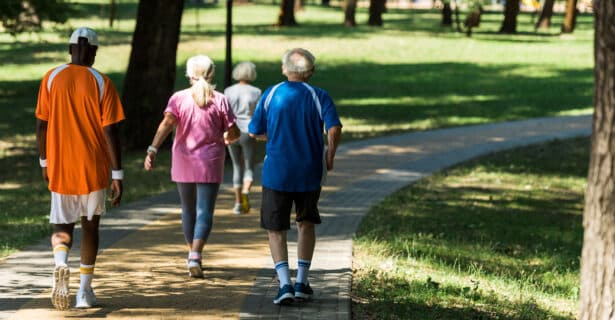
Aerobic Exercise
What is Aerobic Exercise?
Aerobic exercise uses your major muscle groups. It allows your heart rate to increase for a period of time. Examples of aerobic exercise include walking, jogging, cycling, swimming, and using an elliptical machine.
There are different types of aerobic exercise:
- continuous training (such as walking or cycling for 10 minutes at the same pace)
- interval training (such as walking or cycling at faster and slower paces)
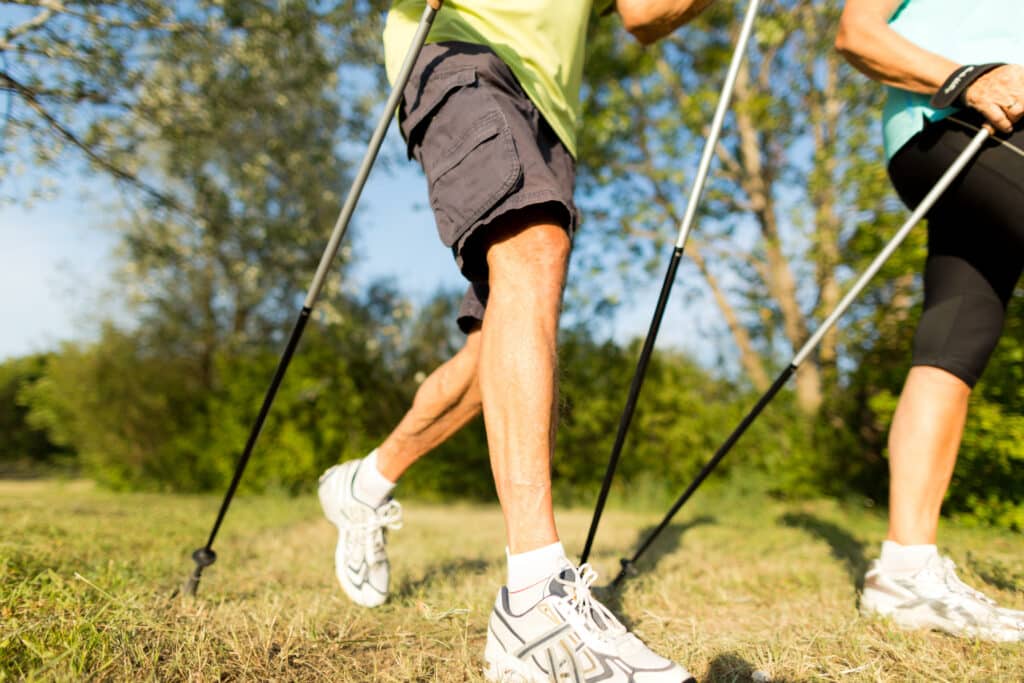
You must warm up your body before doing exercise and cool down your body after.
Safety Alert
If you take insulin or a medicine from the Secretagogue class of medicines you are at risk for low blood sugar (hypoglycemia).
You are more likely to get low blood sugar when you start a new exercise program and when you progress your exercise program.
- Check your blood sugar before and after exercise.
- Always carry a fast-acting carbohydrate with you (such as sugar tablets, juice, or pop).
What is a Warm-Up?
Warm-up means starting to do your exercise slowly.
The purpose of a warm-up is to get your blood flowing to your muscles and prepare your body to exercise. A warm-up also allows your heart rate and blood pressure to rise slowly. This is important so that your exercise intensity (how hard you are working) feels more comfortable.
Match your warm-up to your exercise:
- If you are going to walk for exercise, your warm-up is walking. Take the first 5 to 10 minutes of your walk at a slow and casual pace.
- If you are cycling for exercise, your warm-up is cycling. Take the first 5 to 10 minutes of cycling at a slow pace.
Complete dynamic stretches before you start aerobic exercise. Do your exercise at a slower pace before doing moderate to vigorous activity.
What is a Cool-Down?
The cool-down is at the end of your exercise.
Finish your exercise with 5 to 10 minutes of similar, slow activity. Do static stretches after you complete your exercise to prevent or reduce muscle soreness.
Your cool-down helps lower your heart rate and blood pressure to resting levels. The cool-down prevents you from feeling dizzy or light headed.
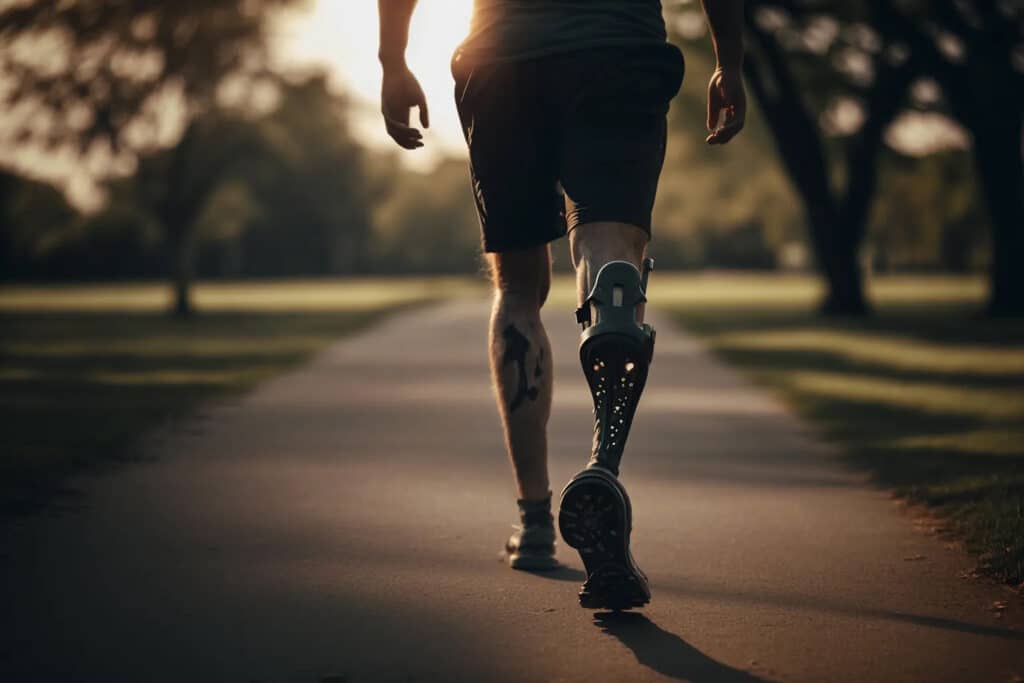
Stretches
Stretching your muscles (flexibility training) is an important part of staying fit. Stretching improves the flexibility of your muscles and reduces the risk of injury when doing aerobic and resistance training.
Stretching exercises are sometimes referred to as warm-up or cool-down exercises. Do not confuse these with the warm-up and cool-down you do as part of your aerobic exercise and resistance training routine.
Two types of stretches are dynamic stretches and static stretches:
Dynamic stretching is done before your warm up and aerobic activity.
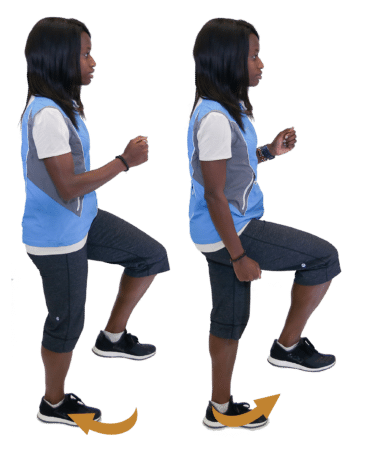
Standing March
- Stand with your feet shoulder width apart.
- Begin to lift one knee up, and then step back down.
- Lift the other knee up, and step back down.
- Alternate leg to leg, marching in one spot.
- Your arms may swing at your sides to help with balance.
- Continue for 10-15 marches per leg.

Shoulder Rolls
- Stand with your feet shoulder width apart.
- Lift both shoulders up towards your ears, and roll them forward and down.
- Continue in a circular motion.
- After 10-15 rotations, change direction and roll your shoulders in the opposite direction (backward and down) for another 10-15 rotations.
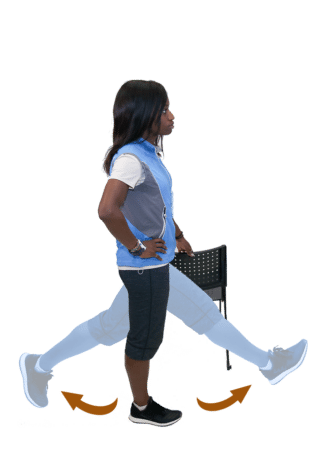
Leg Swing
- Stand beside a chair or ledge to hold onto for balance.
- Holding on with your right hand, begin to swing your left leg back and forth from your hip joint.
- Ensure there is space around for your leg to move freely.
- The swing should be a relaxed, passive motion, not a forced motion.
- After 10-15 swings, switch to other side. Holding on with your left arm, swing your right leg 10-15 times.

Ankle Rolls
- Stand with feet shoulder width apart, and hold on to something for balance.
- Lift your right foot and point the toes to the floor.
- Stand with all your weight on your left foot and rotate your right ankle around in a circular motion. (You can also do this by lifting your right foot off the floor and rotating your ankle so that your toes point in all directions.)
- Repeat the same thing on the other side for 10-15 rotations.
Do static stretches after your aerobic exercise, when your muscles are already warm. Review the safety tips for static stretches:
- Stretch to the farthest point you comfortably can.
- You should feel tightness, but the stretch should not cause pain or discomfort in your muscle.
- Hold the stretch and keep breathing for 15-30 seconds.
- Do not bounce or change position while you are holding the stretch.
Below is a series of upper and lower body stretches you can include in your exercise routine.
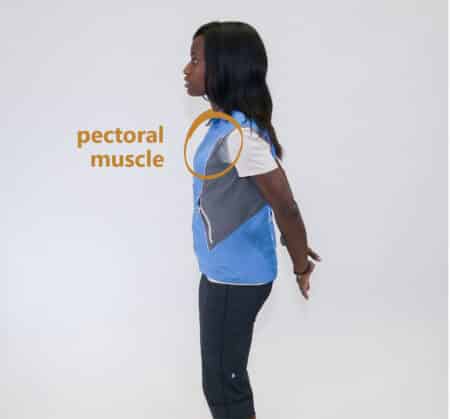
Chest Stretch
- Stand with your feet shoulder width apart.
- Relax your shoulders and make sure they are not hunched up.
- Clasp your hands behind your back. If you cannot clasp them, then place them behind your back.
- Looking straight ahead, open up your chest, and squeeze your shoulder blades together.
- Hold the stretch while continuing to breathe for 15-30 seconds.
- Ensure you feel a stretch, not pain/discomfort.
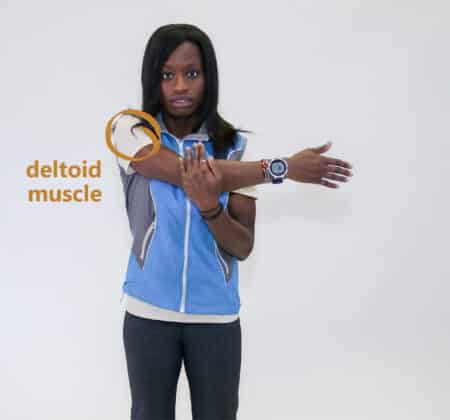
Shoulder Stretch
- Stand with your feet shoulder width apart, arms by your side.
- Relax your shoulders and make sure they are not hunched up.
- Take one arm and bring it across your chest.
- Take the other arm and place it on your elbow to help hold it in position.
- Ensure your arm is across your chest and not across your neck.
- Hold the stretch while continuing to breathe for 15- 30 seconds.
- Ensure you feel a stretch, not pain/discomfort.
- Repeat to stretch the opposite shoulder.
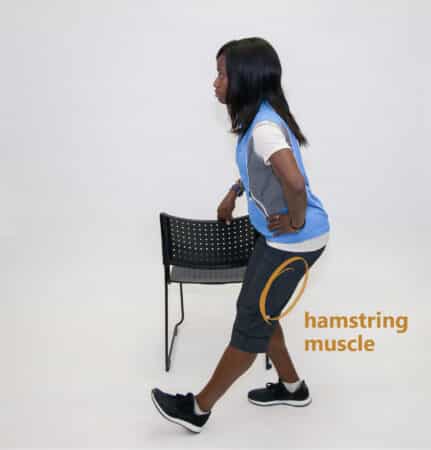
Hamstring Stretch
- Using a wall or chair for support, stand sideways to it.
- Put all of your body weight on one leg and bend that leg.
- Take the opposite leg and place the heel on the floor or on a small step with the toes pointed up. Keep this leg straight.
- From this position, bend forward from the waist – you will feel a stretch in the back of the upper leg that is straight.
- Hold the stretch while continuing to breathe for 15-30 seconds.
- Ensure you feel a stretch, not pain/discomfort.
- Repeat to stretch the opposite hamstring.
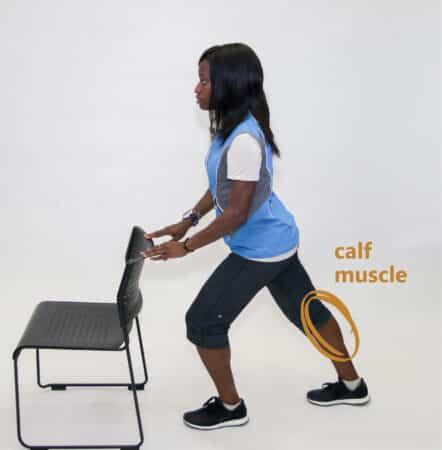
Calf Stretch
- Using a wall or chair for support, face the wall standing with both feet close to it. Place your hands on the wall at chest height.
- Take a step back with one leg keeping that leg straight and lean into the wall keeping the front leg bent.
- Ensure both feet are facing forward.
- As you lean into the wall, you will feel a stretch in the calf of the back leg.
- Hold the stretch while continuing to breathe for 15-30 seconds.
- Ensure you feel a stretch, not pain/discomfort.
- Repeat to stretch the opposite calf.
How Often and How Long Do I Exercise?
Build your exercise routine by aiming to exercise 5 days each week. Slowly increase the time you spend doing exercise to 30 to 60 minutes. Listen to your body and take rest breaks when needed.
Both planned exercise and daily physical activity are important to good health. Be active every day. On the days you do not do planned exercise, find other ways to be active. You can try lower-level activities such as walks with your dog or sports such as golfing.
Lower-level activities help manage your blood sugar and improve your health.
Safety Alert
Do not exercise more than 5 times each week.
Doing more exercise than this increases your risk of muscle or joint injuries and feeling tired or unwell.
How Hard Do I Work?
Intensity level is how hard you are working when you exercise. Measure your intensity level to help you put in the right amount of effort during exercise.
There are 3 ways to measure the intensity of your exercise:
The Borg Rating of Perceived Exertion (RPE) scale is a tool to measure the intensity of your exercise.
RPE is a scale from 6 to 20. You choose a number to describe the amount of effort, strain, or discomfort that you feel during exercise.
- A score of 6 is resting with no effort at all.
- A score of 20 is the most amount of effort you could imagine doing (maximal effort).
For moderate intensity exercise, exercise at a RPE between 11 (fairly light effort, strain, or discomfort) and 14 (between somewhat hard and hard effort, strain, or discomfort). Use the RPE scale to know if you are working too hard during exercise if you could exercise harder.
- If you rated your RPE 15 (hard effort) or higher, slow down your exercise.
- If you rated your RPE at 10 or lower, try to increase your speed or intensity over time.
Borg Rating of Perceived Exertion (RPE) Scale
The table below shows the RPE scale from 11 to 14. For moderate intensity exercise, the goal is to do exercise between 11 and 14.
| RPE Score | Amount of Effort |
|---|---|
| 11 | Fairly light |
| 12 | |
| 13 | Somewhat hard |
| 14 | |
| 15 | Hard |
*Source: Borg, G. (1970) Perceived Exertion as an indicator of somatic stress. Scandinavian Journal of Rehabilitation Medicine, 2 (2), p. 92-98
The talk test is a tool to measure the intensity of your exercise while you exercise. Talk with your exercise partner and notice your breathing.
During moderate intensity exercise, you breathe faster but you can speak without gasping for breaths between words. You should be able to talk with ease but not sing.
Your heart rate is a good measure of your intensity level. Measure your heart rate by feeling and counting your pulse. You can also use a heart rate monitor.
Facts About Your Pulse
Your pulse rate is the same as your heart rate.
- Your pulse rate should go up during exercise because your heart beats faster and harder.
- Your pulse rate may not be the same as someone else’s.
- Some medicines can impact your heart rate.
Taking Your Pulse
To see how your body responds to exercise, measure your pulse rate before and right after exercise (before you cool down).
Note: It is important to count the number of beats you feel for 10 seconds as your heart rate drops quickly after exercise.
You can take your pulse at your wrist (radial pulse)) or at your neck (carotid pulse).
- Put the tip of your index finger and third (middle) finger:
- on your skin at your wrist below the base of your thumb OR
- in the groove of your neck near your windpipe
- Press your fingers into your skin until you feel your pulse. Be careful not to press too hard or you could reduce blood flow.
- Watch a timer or stop watch as you count the number of beats you feel in 10 seconds.
- To know your pulse rate, use a chart or a calculator to multiply the number of beats you counted in 10 seconds, by 6.
- For example at rest, you may feel 12 beats in a 10 second count
- (12 beats) x 6 is 72 beats per minute
Adjust your effort level to make sure you exercise with the right heart rate.
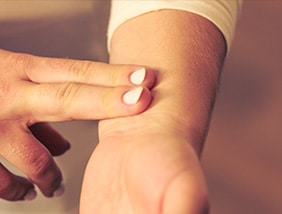
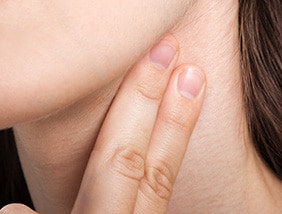
‘Wearables’ are electronic technologies or computers that can be worn on the body or added into items of clothing. Common wearable technologies include heart rate monitors, pedometers, accelerometers, and global navigation satellite system.
Wearables can provide information about the activities you do and how your body responds. Information includes: number of steps, minutes of activity, heart rate (resting and active), distance traveled, sleep data, energy burned, elevation, and stress levels.
If you are thinking about buying a wearable, talk to your exercise specialist if the numbers the device provides are correct. This is very important if you are using the heart rate data to stay in your safe exercise heart rate zone.
You may also want to consider if the device works with your phone as well as price, privacy, and security.
Progress Your Aerobic Exercise
Over time, exercise starts to feel easier. Increase your exercise time and intensity to challenge yourself.
Step 1. Increase time
Increase the amount of time you spend doing exercise by 5 to 10 minutes every 3 or 4 weeks. Add time to your exercise until you are doing a total of 30 to 60 minutes each exercise session. Take rest breaks when needed. You can choose to do 10 minutes of exercise three or more times through the day.
Keep your intensity the same if you increase the amount of time you spend doing exercise.
Step 2. Increase intensity
After 3 or 4 weeks of doing 30 to 60 minute exercise sessions, begin to increase your exercise intensity level.
Use the RPE scale, Talk Test, and heart rate to measure your effort when you increase the intensity of your exercise.
High-intensity interval training involves aerobic training using alternating short periods of higher and lower-intensity exercise. High-intensity interval training may lead to greater gains in cardiorespiratory fitness in people with or without diabetes, and improves glycemic control in people with type 2 diabetes.
Consult with your health care team to see if this is right for you.